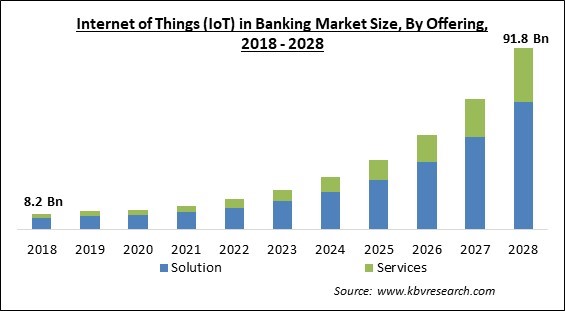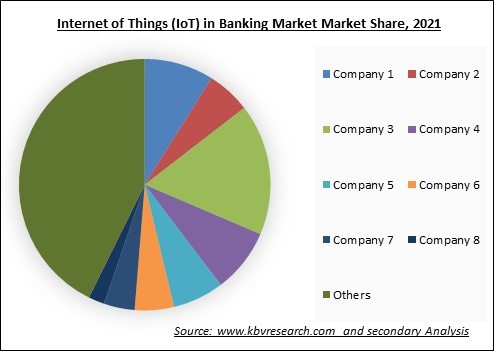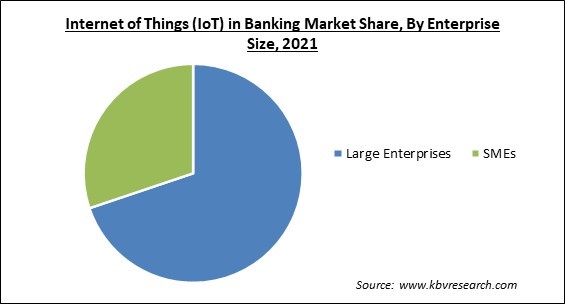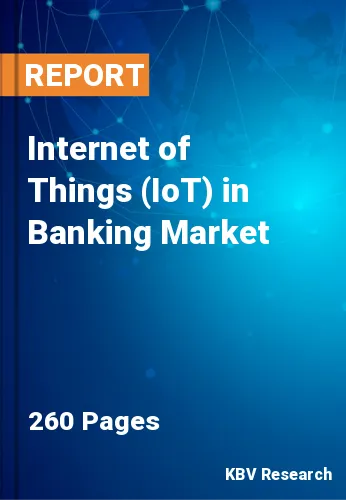The Global Internet of Things (IoT) in Banking Market size is expected to reach $91.8 billion by 2028, rising at a market growth of 34.3% CAGR during the forecast period.
The term "Internet of Things" (IoT) refers to a network of actual physical items, also known as "nodes," that are equipped with software, sensors, and other technologies in order to communicate and exchange data with other systems and devices over the internet. IoT devices are frequently used by banking and financial institutions to offer their clients special services like contactless payments as well as gamified rewards.

Customers who do banking nowadays are recognized to be less dependable, pickier, and more accustomed to the whole range of digital banking services, from self-service to automated wealth advising. Furthermore, the banks are seriously threatened by the cost, consumer expectations, conventional competitors, and fintech factors together.
In order to compete with increased expectations, the focus has shifted to providing new and enhanced experiences as well as greater value for both consumers and staff. IoT is one of the technologies that banks are utilizing. Banks are investigating how IoT may help create goods that especially correspond to client requests in the midst of a big digital upheaval. Owing to an increased emphasis on customer centricity, a few of the biggest banks in the world are restructuring their front offices.
Giving consumers with debit and credit cards convenient access to services is one of the key advantages of IoT in the banking sector. Banks can examine how frequently ATM kiosks are used in particular locations and adjust the location of ATM installations accordingly. Banks can leverage IoT data to provide kiosks and improve client availability in addition to ATMs to provide on-demand services directly to customers. Financial institutions can discover their customers' business demands, their value chain, and obtain customer insights by using the customer data made available by IoT. Such client data can help banks in offering value-added services, financial support, and tailored goods to create a favorable circumstance for both sides.
The vast majority of bank staff worldwide are being urged to work remotely in order to slow the development of COVID-19. The COVID-19 initiative is also challenging customers' ingrained banking practices. The World Health Organization (WHO) has suggested that consumers adopt contactless payment and limit their handling of banknotes. Due to the increased global adoption of the "work from home" lifestyle, the Internet of Things (IoT) in the financial sector is predicted to expand quickly after the pandemic. The market for IoT in banking has seen substantial growth in recent years, but due to the COVID-19 epidemic, banks were compelled to quickly transition their operations to digital platforms. These elements helped IoT in banking expand.
Due to their many high-throughput and productivity-boosting uses, networked technologies like edge computing and IoT devices are gaining significant popularity on the global market. Additionally, a broad variety of vendors are producing IoT devices, which is boosting the penetration of linked devices in the contemporary business environment. Radiofrequency identification (RFID), low-energy Bluetooth, near-field communication (NFC), low-energy wireless, LTE-A, low-energy radio protocols, and Wi-Fi-direct are a few examples of common protocols and technologies used by IoT systems.
IoT applications are getting simpler to design and deploy as governments continue to attempt and upgrade the current cellular networking infrastructure of their nations in order to enhance communication speed and comprehensive connectivity for their inhabitants and the improvement of services. Newer enterprises are encouraged to engage in IoT applications thanks to this expansion in many developing countries. Modern communication technologies are also enabling the employment of authentic monitoring & communication systems, enabling banks and financial institutions to provide real-time payment settlement systems. These elements indicate considerable potential for IoT in contemporary financial applications in the future.
The biggest barrier to IoT adoption is the delicate subject of data protection and security, which is addressed by the majority of banking sector. The banking industry is closely regulated by strict compliance to standards and governance since any data breach or security breach might be fatal. Businesses are feeding increasingly more user and provider data into sophisticated, AI-powered algorithms, creating novel personal data without being aware of how it will affect customers and employees, which subsequently fuels the escalating privacy concerns.

The leading players in the market are competing with diverse innovative offerings to remain competitive in the market. The below illustration shows the percentage of revenue shared by some of the leading companies in the market. The leading players of the market are adopting various strategies in order to cater demand coming from the different industries. The key developmental strategies in the market are Acquisitions, and Partnerships & Collaborations.
Based on offering, the internet of things (IoT) in banking market is bifurcated into Solution and Services. Services segment procured a significant revenue share in the internet of things (IoT) in banking market in 2021. In order to make educated decisions, banks must transform the IoT-derived data into valuable information. Through the data acquired, the banks may grow their market share thereby providing their clients with improved services.
On the basis of deployment type, the internet of things (IoT) in banking market is classified into On-premise and Cloud. On-premise segment recorded the largest revenue share in the internet of things (IoT) in banking market in 2021. On-premise systems' more specialized and secure applications are to responsible for this. Along with that, these solutions are considered to be safer since there is less chance of data breaches and hence are more reliant. Due to this, the growth of the segment would augment in the coming years.
Based on enterprise size, the internet of things (IoT) in banking market is fragmented into Large Enterprises and SMEs. The SMEs segment recorded a significant revenue share in the Internet of Things (IoT) in banking market in 2021. The expansion of IoT in retail banking is projected to be aided by the increasing number of technology expenditures made by small-scale banks to compensate for their smaller fleet of staff. In addition, various benefits of the IoT solutions in banking sector is attracting more SMEs to deploy them and hence, boosting the growth of the segment.
By application, the internet of things (IoT) in banking market is divided into Smart ATMs, Customer Management and Support, Security and Authentication and Others. Smart ATMs segment procured the highest revenue share in the Internet of Things (IoT) in banking market in 2021. Automated teller machines (ATMs) with additional features might be referred to as smart ATMs. Consumers can now do a variety of services that once required an appointment in a local branch, like creating an account, depositing checks & cash, and transfer funds, using smart ATMs.
| Report Attribute | Details |
|---|---|
| Market size value in 2021 | USD 12.2 Billion |
| Market size forecast in 2028 | USD 91.8 Billion |
| Base Year | 2021 |
| Historical Period | 2018 to 2020 |
| Forecast Period | 2022 to 2028 |
| Revenue Growth Rate | CAGR of 34.3% from 2022 to 2028 |
| Number of Pages | 260 |
| Number of Tables | 420 |
| Report coverage | Market Trends, Revenue Estimation and Forecast, Segmentation Analysis, Regional and Country Breakdown, Companies Strategic Developments, Company Profiling |
| Segments covered | Offering, Deployment Model, Enterprise Size, Application, Region |
| Country scope | US, Canada, Mexico, Germany, UK, France, Russia, Spain, Italy, China, Japan, India, South Korea, Singapore, Malaysia, Brazil, Argentina, UAE, Saudi Arabia, South Africa, Nigeria |
| Growth Drivers |
|
| Restraints |
|
Region-wise, the internet of things (IoT) in banking market is analyzed across North America, Europe, Asia Pacific and LAMEA. North America emerged as the leading region in the Internet of Things (IoT) in banking market with the largest revenue share in 2021. The high investment in technological solutions is what is anticipated to fuel the growth of the IoT in banking market over the forecast period. In addition, the expansion of the banking sector in various nations of the region along with the rapid technological advancements would augment the growth of the regional internet of things (IoT) in banking market in the coming years.
Free Valuable Insights: Global Internet of Things (IoT) in Banking Market size to reach USD 91.8 Billion by 2028

The market research report covers the analysis of key stake holders of the market. Key companies profiled in the report include Microsoft Corporation, IBM Corporation, SAP SE, Oracle Corporation, Cisco Systems, Inc., Accenture PLC, Infosys Limited, Capgemini SE, Software AG and Vodafone Group Plc.
By Offering
By Deployment Model
By Enterprise Size
By Application
By Geography
The Internet of Things (IoT) in Banking Market size is projected to reach USD 91.8 billion by 2028.
Increase in Applications for IoT Solutions in Banking Sector are driving the market in coming years, however, Rise in The Cases of Data and Security Breaches restraints the growth of the market.
Microsoft Corporation, IBM Corporation, SAP SE, Oracle Corporation, Cisco Systems, Inc., Accenture PLC, Infosys Limited, Capgemini SE, Software AG and Vodafone Group Plc.
The expected CAGR of the Internet of Things (IoT) in Banking Market is 34.3% from 2022 to 2028.
The Solution market shows high market share in the Global Internet of Things (IoT) in Banking Market by Offering in 2021, thereby, achieving a market value of $64.7 billion by 2028.
The Large Enterprises market is leading the market in the Global Internet of Things (IoT) in Banking Market by Enterprise Size in 2021, thereby, achieving a market value of $61.4 billion by 2028.
Our team of dedicated experts can provide you with attractive expansion opportunities for your business.

